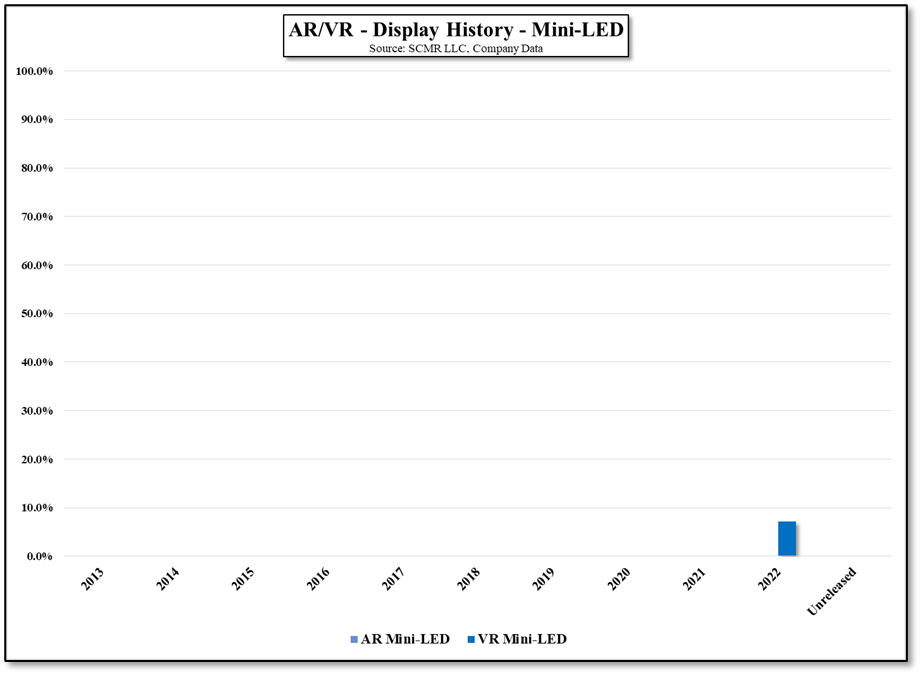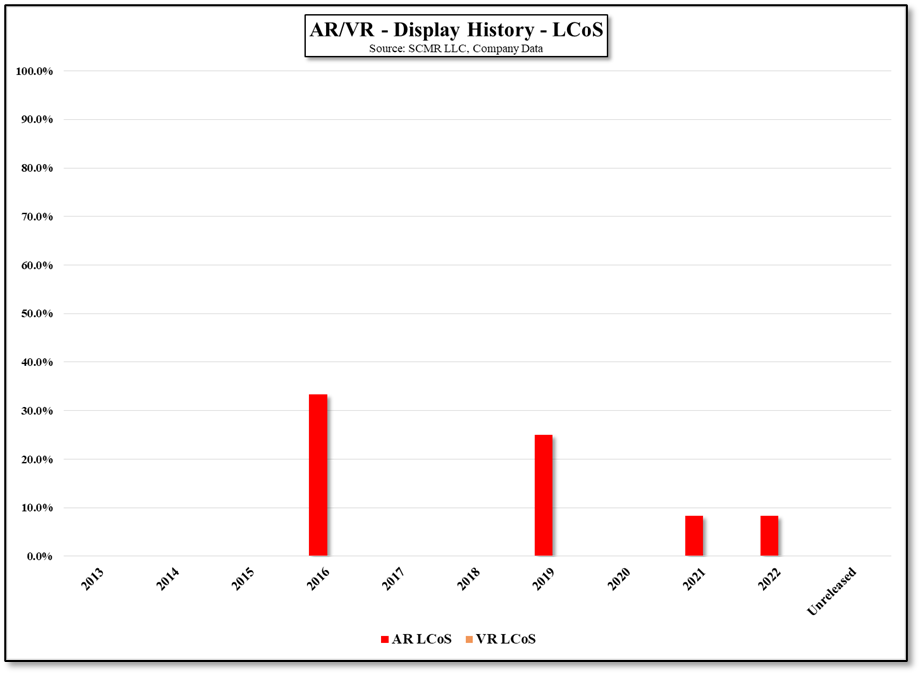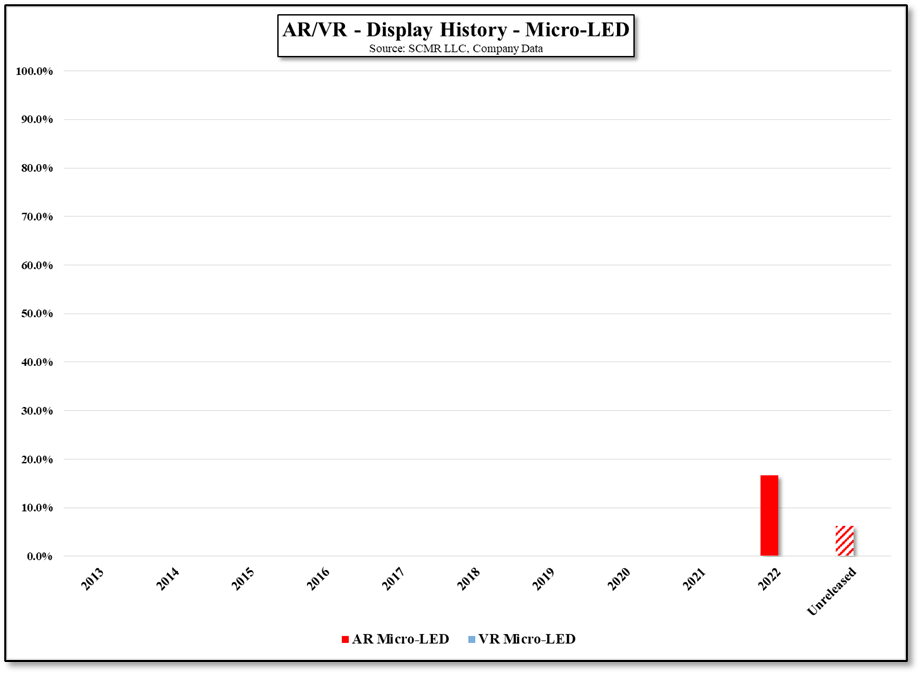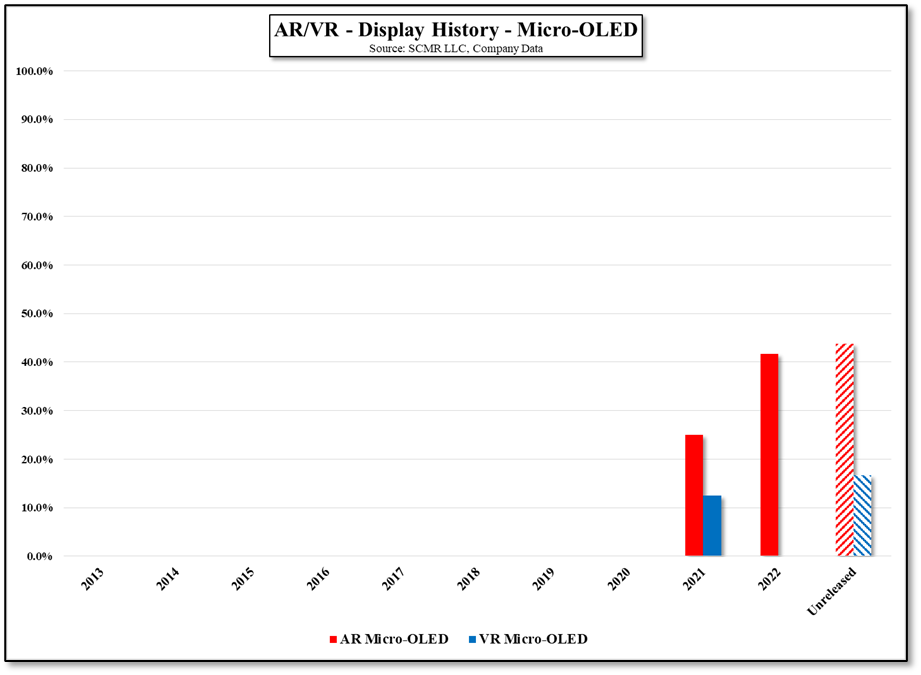AR/VR Display Primer
We do believe that the adoption of XR will be somewhat generational, with those that have grown up with smartphones as an extension of their bodies and personalities more willing to accept the notion of XR without the trepidation that comes from a generation that grew up with radio and TV as ‘social media’, and that will take time, but we believe the adoption of XR by Apple (AAPL) will help to legitimize XR and push it further into the more consumer oriented spotlight. We do see a bit of a divergence between the two components of XR, with AR being the more practical application and VR having a more entertainment oriented focus, although AR will continue to have a smaller share of the XR unit total at least for the next year or so. We also expect the two segments to merge somewhat, with a number of devices allowing the user to use the headset as an AR device, while also providing for a ‘blocking’ system that will allow the user an immersive VR experience.
Aside from the potential usage characteristics for XR, there is another important aspect of XR devices that needs to be addressed, that of ‘wearability’, and by wearability we do not mean how comfortable a headset might be but more how it looks to the outside world. We have all seen pictures of those wearing VR headsets wildly gesticulating as they stand in the middle of a room or sit on a couch, and that is certainly an image that does not serve to entice a broad swath of consumers to try such a device, although it is likely quite attractive to the gaming population. More to the point would be AR headsets, which are slowly evolving into devices that are close to normal glasses, thanks to optical solutions like pancake lenses, that reduce the bulk behind AR headsets, which makes them more practical for their use as an ‘everyday’ item that can be worn without the stigma of a VR headset, and will eventually become unobtrusive to consumers.
Of course there are many practical applications for both AR and VR, but while VR unit volumes are substantially higher than AR unit volumes, we see AR as the more ubiquitous device for the long-term, especially from a generational standpoint, with the information currently presented on a smartphone display projected in front of you, without blocking normal vision, a way of reducing the need to look at a screen that you have to take out of a pocket as it is always on and in front of you.
Right now, we have to look at the XR space more from the standpoint of a typical consumer device, and as almost all consumer devices have a visual interface, we start with the displays that have been and will be used in AR and VR devices. There are a number of existing and potential displays that have been and can be used in AR and VR devices, so we offer a bit of a primer on what they are, how they work, and our data on which are gaining or losing traction. We note that these displays tend to be more complex to manufacture than smartphone displays, particularly as they are situated within millimeters of the user’s eyes, making the resolution and pixel pitch[1] key metrics. Such displays are considered ‘near-eye’ displays and while they are typically produced on display production lines similar to those used to produce CE displays, their characteristics are pushing the technology needed to satisfy near-eye criteria toward less typical production methods.
Most CE displays are based on a glass or plastic substrate, and while those platforms are certyainly acceptable for typical CE displays, the higher tolerances of near-eye displays have pushed development toward silicon-based displays, which are just beginning to show merit as to reducing the feature sizes needed for near-eye displays. What makes this even more attractive to display producers is the processes use equipment that display producers already have on the fab floor, particularly semiconductor lithography tools that are used to make display TFT backplanes. This gives the DoS (Display on Silicon) world a path into the future that requires potentially less capital and infrastructure than would be the case for a ‘new’ display technology, and gives the industry an easier path to building pilot DoS lines to further develop the technology.
That said, the AR/VR industry still has the necessity of having access to mass production that can keep costs at reasonable levels and that tends to lean toward existing display modalities, so we looked at all of the AR/VR devices produced since 2013 and traced the display types used in those devices. Not all of the device manufacturers have been forthcoming about the type of display used, so there is an ‘unknown’ component, but we broke down the display usage into groups for those that disclosed the information, using the manufacturers ‘classification’ as to the type of display. In some instances there were nuances that made us wonder if the AR/VR brand was accurately portraying the dive display, but without disassembling a multitude of AR/VR headsets, we took the brand’s word at face value.
This broke down the displays into eight categories based on four technologies, Liquid Crystal displays (LCD), OLED displays, LED displays, and DLP, which we describe in brief below.
- Liquid Crystal Display (LCD) – A display in which light is generated by a BLU (backlight unit), which passes through or is blocked by a liquid crystal material. The liquid crystal is ‘controlled’ by TFT (Thin-film Transistors) circuitry that can shift the optical characteristics of the liquid crystal to let the light through or block it. If the liquid crystal is ‘open’, the light passes into a color filter, essentially a sheet of red, green, and blue phosphors that change the white backlight to their respective colors.
- OLED Displays (OLED) – A display that uses phosphorescent and fluorescent materials that emit light when controlled by a TFT system similar to that used in LCD displays. In small OLED displays, the OLED materials are arranged to form a pixel composed of red, green, and blue OLED materials, each of which can be individually controlled. Since these materials are self-emissive, there is no need for a color filter.
- LED displays (LED) – As mentioned above, LCD displays require a backlight that is usually an array of LEDs (Light-emitting Diodes), and in most cases the term ‘LED display’ is used to mean an LCD display that uses an LED backlight, however, there are also display technologies that are based on the LEDs themselves as emitting devices. In some cases individual red, green, and blue LEDs are used as self-emissive components, similar to the way OLED materials are used, and in other instances single color LEDs are used, using a number of methods for converting the color of the light (more below).
- DLP (Digital Light Processing) – This technology uses a white light source that is split into primary colors. Three micro-mirror chips for each pixel, which are individually controlled, reflect the prism’s light or block it, to create each pixel’s color combination. More commonly used in cinema projection systems, the technology is rarely used in near-eye devices.
- Mini-LED – Essentially an LCD display, but with much smaller LEDs in the backlight, giving a higher level of control over each pixel.
- QLED (Quantum Dot) – Similar to the Mini-LED above, these displays use quantum dots to narrow the spectrum of the LED light and enhance the color characteristics. In some cases, the quantum dots can be used as a substitute for the color filter, shifting the white light to red, green, and blue, rather than filtering to preserve brightness.
- LCoS (Liquid crystal on Silicon) – Similar to DLP and LCD, LCoS uses liquid crystal to reflect or block the RGB light sources, and is based on a silicon substrate. LCoS is also used for projection devices but has been used in some near-eye displays.
- Micro-LED – Micro-LED displays are based on self-emissive LEDs that are either a single color or have a red, green, and blue LED for each pixel. In single color micro-LED displays quantum dots are typically used to shift the single color light to RGB as RGB micro-LEDs are relatively difficult to produce.
- Micro-OLED – Similar to more typical self-emissive RGB OLED displays, micro-OLED displays are produced on silicon and do not use typical evaporative OLED material deposition. While there are a number of potential micro-OLED processes, rather than the masks used to create pixels with OLED materials, micro-OLED displays are created using photolithography on silicon.
- eQD – While not in our data for existing AR/VR headsets, we note that at some point in the future we expect that quantum dots will also be used as a self-emissive light source, likely based on silicon photolithography. Right now QDs are typically used as ‘color shifters’ converting one color of light to another, a step above phosphors which filter out other colors. By electrically or optically stimulating QDs, they give off light that is easily tailored to specific colors. Not yet a product but one that will inevitably be used in near-eye displays.
LCD is still the Oculus 2 (FB), the only release in 2014 contained an OLED display, giving it dominance that year, and while OLED has seen its share decline in both AR and VR over the last few years, Figure 11 shows that Micro-OLED is gaining traction over the last two years, and in those devices still unreleased. Mini-LED, Micro-LED and QLED near-eye displays are still in the emerging category, while DLP has disappeared. LCoS, as a reflective technology remains viable for AR (Magic Leap (pvt)), but we expect micro-OLED and modern optics will lessen its appearance.
Once again, we note that regardless of the forecasts for XR, the CE space is always looking for new hardware to sell, and while AR/VR is a bit different than your usual CE fare, it has the potential to become another revenue source for CE companies and the display industry. As few CE devices are not display oriented in some way, we focus considerable attention to the display space to spot trends, both in the near-term and on a long-term basis. Should a large CE company decide that XR is a viable consumer product, the media will blast the web with headlines about the merits of AR/VR and how it will change the world and the way we see it. Therefore, we look to keep one step ahead and look to spot trends and direction that will move the XR space ahead or delay its (2nd or 3rd) ‘dawning’.
[1] Pixel pitch is the distance from the center of a pixel to the center of an adjacent pixel and is usually measured in millimeters or microns.












 RSS Feed
RSS Feed